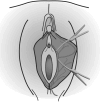A road map through the multi-faceted world of female genital cosmetic surgical techniques
- PMID: 39829188
- PMCID: PMC12177275
- DOI: 10.1002/ijgo.16169
A road map through the multi-faceted world of female genital cosmetic surgical techniques
Abstract
The demand for female genital cosmetic surgery (FGCS) has significantly increased in recent years for two reasons: the advancement of surgical operations and the increased attention to women's esthetic and sexual well-being. Three authors independently analyzed different databases up to April 1, 2024. They selected the relevant data according to inclusion and exclusion criteria. Two team members retrieved and evaluated the full text of the articles for eligibility, extracted the data independently, and included populations, intervention type, and outcomes using a pre-piloted standard method. Any disagreement over the eligibility of some articles was resolved through discussion with an external collaborator. Considering the growing interest in FGCS procedures, the present review aims to analyze the most up-to-date surgical techniques, to provide adequate evidence-based surgical training, in order to avoid complications. Labiaplasty aims to reduce excess labial tissue. To perform this procedure, it is possible to implement several techniques, that have recently been updated to ensure the lowest rate of complications and the best esthetic result. Vaginoplasty involves strengthening the vaginal wall and repairing vaginal lesions or asymmetries. Perineoplasty, the technique of choice in all scenarios in which perineal trauma occurs, is achieved by strengthening the perineal body and restoring the rectovaginal fascia. Other procedures described are labia majora augmentation, mons pubis surgery, clitoral hood reduction, lipofilling, and hymen reconstruction. Our review emphasizes that robust, evidence-based training is required before performing such procedures, to avoid ineffective and potentially harmful surgical practices.
Keywords: cosmetic surgery; evidence‐based training; labiaplasty; perineoplasty; vaginoplasty.
© 2025 The Author(s). International Journal of Gynecology & Obstetrics published by John Wiley & Sons Ltd on behalf of International Federation of Gynecology and Obstetrics.
Conflict of interest statement
The authors have no conflicts of interest.
Figures




Similar articles
-
Using Google Trends for Evaluation of Public Interest in Female Genital Aesthetic Procedures.Dermatol Surg. 2023 Aug 1;49(8):762-765. doi: 10.1097/DSS.0000000000003832. Epub 2023 May 9. Dermatol Surg. 2023. PMID: 37523594
-
FIGO statement: Cosmetic genital surgery.Int J Gynaecol Obstet. 2025 Jul;170(1):11-14. doi: 10.1002/ijgo.70203. Epub 2025 Jun 5. Int J Gynaecol Obstet. 2025. PMID: 40471219
-
Vaginal labiaplasty: current practices and a simplified classification system for labial protrusion.Plast Reconstr Surg. 2015 Mar;135(3):774-788. doi: 10.1097/PRS.0000000000001000. Plast Reconstr Surg. 2015. PMID: 25719696
-
Clinical, Ethical, and Legal Considerations Raised by Self-Reported Genital Mutilation Following Voluntary Cosmetic Labiaplasty.Arch Sex Behav. 2025 Jan;54(1):399-415. doi: 10.1007/s10508-024-03058-2. Epub 2024 Dec 27. Arch Sex Behav. 2025. PMID: 39730955 Free PMC article.
-
The contribution of online content to the promotion and normalisation of female genital cosmetic surgery: a systematic review of the literature.BMC Womens Health. 2015 Nov 25;15:110. doi: 10.1186/s12905-015-0271-5. BMC Womens Health. 2015. PMID: 26608568 Free PMC article.
References
-
- Heller DS, Kuye OO. Recurrent hypertrophy of the labia minora: a hormonally related lesion possibly related to fibroepithelial stromal polyps of the vulva. J Low Genit Tract Dis. 2011;15:69‐70. - PubMed
-
- Barrett MM, Carlson JA. A clinicopathologic study of labia minora hypertrophy: signs of localized lymphedema were universal. J Low Genit Tract Dis. 2014;18:13‐20. - PubMed
Publication types
MeSH terms
LinkOut - more resources
Full Text Sources
Medical
Miscellaneous

